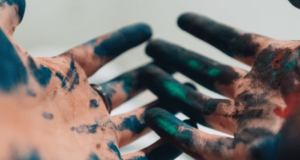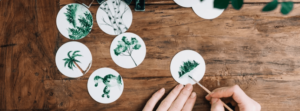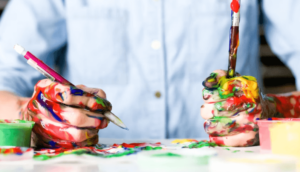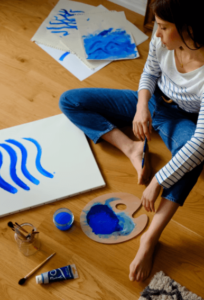“Paint mindfully” is a common phrase for those who love to paint. It can be applied in many ways, but this article will focus on painting as a form of self-expression and mindfulness. Painting has been shown to promote relaxation and reduce stress levels, which is why it’s such an essential part of the healing process.
You’ll find what you need here for those looking for something that provides both meaning and intention to their art.

What is mindfulness, and how does it relate to art?
One study found that mindfulness can help reduce stress levels by simply being present in the moment. Being mindful of one’s thoughts, feelings, bodily sensations, and surrounding environment is essential when painting – because it will allow you to experience your art without preconceived notions or expectations.
The key here is allowing yourself to be fully immersed in what you are creating to see things from a different perspective with every stroke. If this feels hard for no good reason (you’re not thinking about anything specific), try naming colors as they appear on your canvas before putting them down – like seeing an image but “seeing” color instead of object recognition.
It may sound silly at first, but give it a shot! You’ll thank yourself later on when you see your finished piece of art.
How can painting be a form of mindfulness?
To some, the process of making art may not seem like it’s related to being mindful at all – but don’t worry! It is.
The whole idea behind “paint mindfully” is that one must have an intention in every stroke they make so that their focus remains on what they are creating rather than outside distractions or other thoughts running through their mind at once.
This doesn’t mean that there isn’t room for creative freedom and spontaneity, though. You will get out whatever you put into it with this mindset – whether it comes across as happy little trees or something darker entirely.

So how does one paint mindfully?
Paint mindfully by choosing a focal point and color palette to work with. Some colors go better together than others, so you want to ensure that the colors you choose complement one another well. However, there is no right or wrong way here – it’s simply about what works for your piece of art as a whole.
The other part of painting mindfully is attempting shapes and objects rather than images from real life. In this case, less is more because every line counts toward giving the picture some meaning instead of trying to create something realistic (in which case it would be overkill).
The beauty lies in seeing how much detail can be put into a specific shape or object before needing something else to fill in the space. This is where you can get creative and see what your mind can come up with when it’s turned loose on a blank canvas!
What are some other ways that painting can be mindful?
One of the essential parts of mindfulness while creating art (or anything for that matter) has nothing whatsoever to do with how well you paint or draw – but instead, why you create at all.
Painting may have therapeutic properties, but there are reasons behind every action we take as human beings – especially under duress. Being able to pinpoint exactly what was going through your head during this time will help give meaning to any piece of artwork that you produce afterward so that others who view your work can better relate.
If you can express yourself clearly and succinctly, this will be a massive benefit in the future when people view your artwork because they’ll have an idea of what was going on with you at that time. In addition, this may help them understand why some things look a certain way or how it makes them feel – which is essential for art-making.
Why you should paint mindfully
Everyone has their reasons for why they paint or draw. Some people do it because it’s fun, while others might need to express themselves in ways that words can’t describe. Whatever your reason is for painting, the act of adding meaning and intention into your art is what will make you grow as an artist.

At any point in time, you can improve your skills as a painter. And it’s all about adding meaning to what you do.
One of the most important things to keep in mind when painting is that no mistakes are allowed. In other words, if an accident happens and something doesn’t turn out how you wanted, don’t get mad or upset with yourself! Instead, take this opportunity to learn from whatever mistake happened so that you won’t make the same error again next time around.
Besides accepting failure as part of life itself, taking advantage of these moments will help build up your confidence even more because each time one thing goes wrong. Another will usually go right afterward due to trial and error exposure during practice sessions. You’ll never know what you can do until you push yourself to your limits.
What about color?
When it comes down to the basics of painting, adding intention and meaning with each brushstroke is more critical than worrying too much about how exactly a specific hue looks. Instead of thinking about every single detail that goes into creating art, think: “Does this background look nice?” or “Is my character wearing clothes I want them to wear?”.
Do not worry so much if the colors are off-tone because at least you thought they were accurate when doing so as long as it’s pleasing for others who also see your work!
After all, there’s no such thing as an ugly color, even though some might appear unappealing on the surface.
Sometimes, the best way to meditate and calm your mind, besides deep breathing, is to look at the art you’ve done. Not necessarily to show other people, but rather because it gives you a sense of pride and accomplishment when looking back on what was created during your session.
Keep this in mind: No one can tell you how to paint or draw except yourself! So instead of seeking advice from others who might not fully understand what’s going inside your head, such as friends and family members, keep practicing so that next time around they’ll be able to give more positive feedback instead of just saying, “that looks nice!” without understanding why it does.
One last thing about mindfulness is that no two artists are alike due to their unique perspectives and inspirations behind every stroke they make on paper or canvas. There will be moments where you might not like your art, but instead of giving up on it entirely, take this time to reflect upon what you can do better next time. If anything, painting should be fun and educational at the same time!

Tips for painting with intentionality in your daily life
- Take a deep breath and relax before you begin painting. The world will wait for you to get your bearings in order.
- Begin with the basics, such as drawing shapes or triangles, squares, etc., which helps build confidence since it’s easy to make mistakes by starting too quickly!
- What might seem like a mistake can be used later on if done right?
- Practice makes perfect anyway, so no one will expect perfection from anyone else either way unless they’re an art teacher grading work done during class time!
- It should always be fun even when trying new things because there are always learning opportunities waiting ahead whenever you encounter obstacles along the way.
- If anything, don’t give up because nothing great comes easily without any effort at all!
- Don’t worry about making mistakes when painting – it’s the only way to learn!
- It’s okay if colors don’t look that great together, in your opinion, but others might think otherwise.
- Use shapes and triangles to practice drawing before moving onto more complex objects such as people or animals.
- There are always learning opportunities waiting ahead whenever you encounter obstacles along the way, so never give up!
Paint should be fun even when trying new things because there are always learning opportunities waiting ahead whenever you encounter obstacles along the way. Especially for art teachers grading work done during class time, no one will expect perfection from anyone else either way unless they’re an art teacher grading work done during class time.
Final words
Being mindful is a great way to feel relaxed and peaceful while painting, which is why more people should get into this hobby because it’s fun.
Don’t worry about making mistakes when painting – it’s the only way to learn. Instead, paint with intentionality in your daily life by taking deep breaths instead of worrying so much about every single detail that goes into creating art, such as colors being off-tone or not thinking about what you want out of an object.
The world will wait for you to get your bearings in order whenever necessary, just like anyone else who might have their unique perspectives and inspirations behind every stroke they make on paper or canvas. There will be moments where you don’t like your work but take time to reflect upon what you can do better next time around.
If anything, painting should be fun and educational at the same time.
